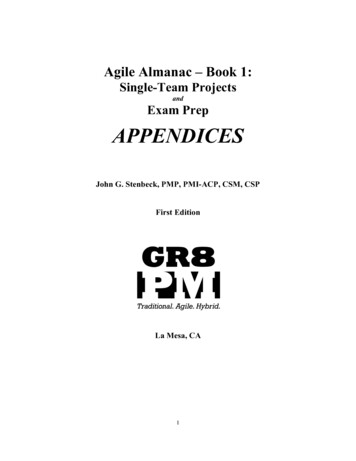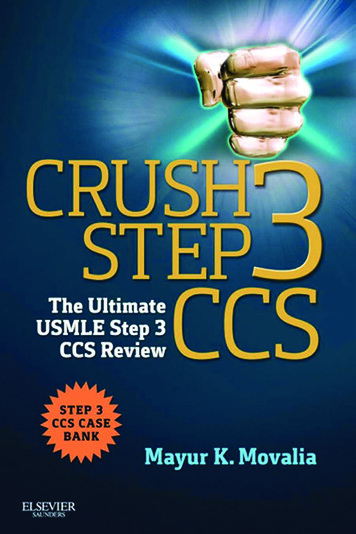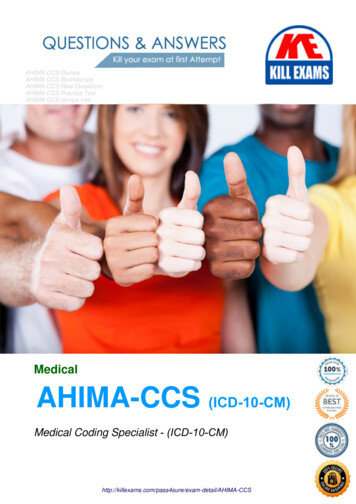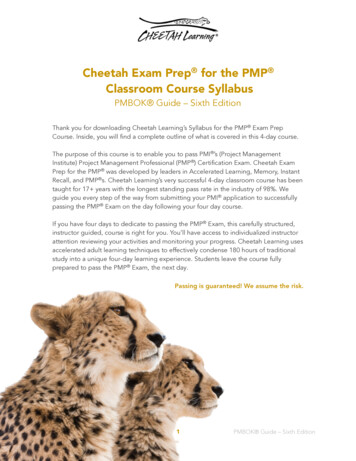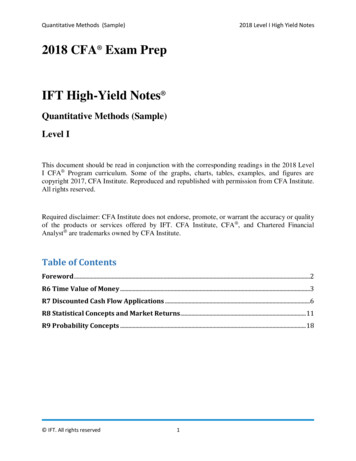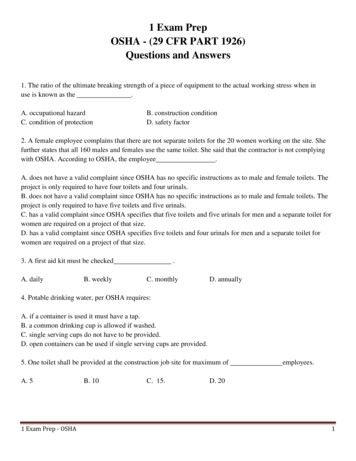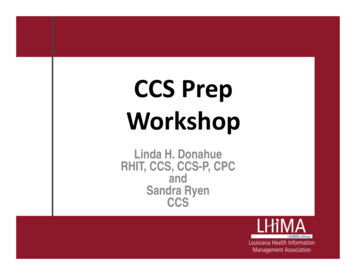
Transcription
CCS PrepWorkshopLinda H. DonahueRHIT, CCS, CCS-P, CPCandSandra RyenCCS
Linda’s Bio Graduated with A.S. in Health InformationTechnology from DCC in May 1996 RHIT in 1996 CCS‐P in 2002 CPC in 2003 CCS in 2005 ICD‐10‐CM/PCS Approved AHIMA Trainer in2009‐Present Employed as HIT/Coding Instructor at DCCsince 2001
Sandy’s Bio Graduated with a CTS in Medical Codingfrom DCC in December 2011 CPC‐A in 2012 CCS in 2014 Selected as Intern at Ochsner HealthSystem before becoming an InpatientCoder
What are Certified CodingSpecialists?CCSs are skilled in classifyingmedical data from patient records,generally in a hospital setting. Thesecoding practitioners: Review patients’ records and assign alphanumeric codes for each diagnosis andprocedure. Possess expertise in the ICD-10-CM and CPTcoding systems Are knowledgeable about medical terminology,disease processes, and pharmacology.
Where can a CCS Work?Different facilities and institutionsmake use of a CCSs' skills: Hospitals and medical providers take thecoded data created by CCSs to insurancecompanies—or to the government in thecase of Medicare and Medicaid recipients—for reimbursement of expenses. Researchers and public health officials alsouse this data to monitor patterns and explorenew interventions. They are considered coding experts!
Why Should You Take the CCS Exam Employment OpportunitiesBetter JobPromotionProfessional DevelopmentWant to promote yourself as a expert ICD‐10‐CM/PCS Coder
CCS Certificationwww.ahima.org/certification/ccs.aspx Professionals experienced in codinginpatient and outpatient records shouldconsider obtaining this certification. You do not have to be a member of AHIMAto take this exam. Discount to AHIMA Members. CCS Candidate Guide Available FreeOnline.
CCS Certification
TIPS FOR SUCCESS Read through the entire candidateguide! Visit AHIMA’s exam preparation page at:www.ahima.org/certification
“Big 3” QuestionsAm I qualifiedto take thisexam?How muchdoes it cost?Time?
CCS Exam Eligibility Requirements for2016 By Credential: RHIA , RHIT , or CCSP OR By Education: Completion of a codingtraining program that includes anatomy &physiology, pathophysiology, pharmacology,medical terminology, reimbursementmethodology, intermediate/advancedICD diagnostic/procedural and CPTcoding; OR
CCS Exam Eligibility Requirements for 2016 By Credential with Experience: CCA plusone (1) year of coding experience directlyapplying codes; OR Other Coding credential from other certifyingorganization plus one (1) year codingexperience directly applying codes.NOTE: Check for Eligibility FAQ Document athttp://www.ahima.org/certification/CCSif you still have questions.
Exam FeesCertified Coding Specialist (CCS) Member ‐ 299 Non‐Member ‐ 399
Let’s Begin Our Journey You are here so we know that you areinterested in taking the CCS Exam. We are here to help you prepare forthis exam. Let’s take off tofind our way toCertification!
Applying for CCS Exam Download Candidate GuideCheck EligibilityComplete ApplicationReview Exam Application ChecklistRegister Online or via Paper ApplicationComplete Special Accommodations Forms, ifApplicable Submit all paperwork necessary (transcripts,resume, other documentation)
Next Step to the CCS Exam1)2)3)4)Wait for authorization to test (ATT)Four Month Window Available!Schedule Exam with Pearson VUEVerify what materials and form(s) of IDare need at testing center.5) Verify time and date of exam.6) Begin CCS Prep if you haven’t already!
How Do I Study? The Exam Content Outline is yourroadmap to studying. A Study Plan is essential. Keeping on track will lessen your stressnear the time of the exam. Finding a study partner may help. Think of the knowledge that you will attainby preparing for this exam!
CCS Exam Content OutlineNumber of Questions on exam: 97Multiple‐choice questions (79 scored/18 pretest) 8 medical scenarios (6 scored/2 pretest)Exam Time: 4 hours – no breaks
Domain I. – Health InformationDocumentation (8% ‐ 10%)Tasks:1.2.3.4.5.6.7.Interpret health record documentation using knowledge ofanatomy, physiology, clinical indicators and diseaseprocesses, pharmacology and medical terminology to identifycodeable diagnoses and/or proceduresDetermine when additional clinical documentation is neededto assign the diagnosis and/or procedure code(s)Consult with physicians and other healthcare providers toobtain further clinical documentation to assist with codeassignmentCompose a compliant physician queryConsult reference materials to facilitate code assignmentIdentify patient encounter typeIdentify and post charges for healthcare services based ondocumentation
Domain II. – Diagnosis & ProcedureCoding (64%‐68%)Tasks (Part I):1.2.3.4.5.Diagnosis:Select the diagnoses that require coding according to current coding andreporting requirements for acute care (inpatient) servicesSelect the diagnoses that require coding according to current coding andreporting requirements for outpatient servicesInterpret conventions, formats, instructional notations, tables, anddefinitions of the classification system to select diagnoses, conditions,problems, or other reasons for the encounter that require codingSequence diagnoses and other reasons for encounter according tonotations and conventions of the classification system and standard dataset definitions(such as Uniform Hospital Discharge Data Set [UHDDS])Apply the official ICD‐10‐CM coding guidelines
Domain II. – Diagnosis & ProcedureCoding (64%‐68%)Tasks (Part II):1.2.3.4.5.6.Procedure:Select the procedures that require coding according to currentcoding and reporting requirements for acute care (inpatient)servicesSelect the procedures that require coding according to currentcoding and reporting requirements for outpatient servicesInterpret conventions, formats, instructional notations, anddefinitions of the classification system and/or nomenclature toselect procedures/services that require codingSequence procedures according to notations and conventions of theclassification system/nomenclature and standard data setdefinitions(such as UHDDS)Apply the official ICD‐10‐PCS procedure coding guidelinesApply the official CPT/HCPCS Level II coding guidelines
Domain III. – Regulatory Guidelinesand Reporting Requirements for AcuteCare (Inpatient) Service (6‐8%)Tasks:1. Select the principal diagnosis, principal procedure, complications,comorbid conditions, other diagnoses and procedures that requirecoding according to UHDDS definitions and Coding Clinic2. Assign the present on admission (POA) indicators3. Evaluate the impact of code selection on Diagnosis Related Group(DRG) assignment4. Verify DRG assignment based on Inpatient Prospective PaymentSystem (IPPS) definitions5. Assign and/or validate the discharge disposition
DOMAIN IV. Regulatory Guidelines andReporting Requirements for OutpatientServices (6‐8%)Tasks:1. Select the reason for encounter, pertinent secondary conditions,primary procedure, and other procedures that require codingaccording to UHDDS definitions, CPT Assistant, Coding Clinic, andHCPCS2. Apply Outpatient Prospective Payment System (OPPS) reportingrequirements: a. Modifiers b. CPT/ HCPCS Level II c. Medicalnecessity d. Evaluation and Management code assignment (facilityreporting)3. Apply clinical laboratory service requirements
DOMAIN V. Data Quality andManagement (2‐4%)Tasks:1. Assess the quality of coded data2. Communicate with healthcare providers regarding reimbursementmethodologies, documentation rules, and regulations related tocoding3. Analyze health record documentation for quality and completenessof coding4. Review the accuracy of abstracted data elements for databaseintegrity and claims processing5. Review and resolve coding edits such as Correct Coding Initiative(CCI), Medicare Code Editor (MCE) and Outpatient Code Editor(OCE)
DOMAIN VI. Information andCommunication Technologies (1‐3%)Tasks:1. Use computer to ensure data collection, storage, analysis, andreporting of information.2. Use common software applications(for example, word processing,spreadsheets, and email) in the execution of work processes3. Use specialized software in the completion of HIM processes
DOMAIN VII. Privacy, Confidentiality, Legal,and Ethical Issues (2‐4%)Tasks:1. Apply policies and proceduresfor access and disclosure of personalhealth information2. Apply AHIMA Code of Ethics/Standards of Ethical Coding3. Recognize and report privacy and/or security concerns4. Protect data integrity and validity using software or hardwaretechnology
DOMAIN VIII. Compliance (2‐4%)Tasks:1. Evaluate the accuracy and completeness of the patient record asdefined by organizational policy and external regulations andstandards2. Monitor compliance with organization‐wide health recorddocumentation and coding guidelines3. Recognize and report compliance concerns
Feeling Overwhelmed!
TIPS FOR SUCCESSYou will be able to:Review exam specifications.Review content outline.Allow enough time to prepare forthe exam.“Cramming” is discouraged!”
Create a Study PlanSteps:1) Assess your current schedule.2) Use the CCA Exam Content Outline3) Buy or Pull out your calendar/planner.4) Schedule study sessions in block of 30minutes to one hour and then take abreak.5) Check off Tasks on the Study Plan.6) Stick to your Schedule!
Steps for Success Assess your coding skills and review basicICD‐10‐CM and ICD‐10‐PCS codingprinciples. Utilize coding textbooks.NOTE: If you have not been formally trainedin ICD‐10, you may want to purchase theAHIMA Training Manuals or ICD‐10‐CM/PCS Coding Textbook and start fromthe beginning. Review CPT Coding Textbook.
Steps for Success Review Coding Clinic, if available, and/orregister for Free Webinars online. Review CPT Assistant Articles, if available.NOTE: These are available on 3M and otherEncoders.
Steps for Success Utilize CCS Exam Prep Books and takePractice Exams. Use the Self‐Assessment Tool Available atthe Workshop when taking PracticeExams. Adjust your Study Plan according to resultsof Practice Exams.
Steps for Success Knowledge of common MS‐DRGSregarding which will be affected bycomorbidities or complications (CCs). Understand how to determine principaldiagnosis assignment according to theStandards of Ethical Coding.
Steps for Success Remember that your ICD‐10 and CPTCodebooks are your best resource! They contain a wealth of information andguidelines to assist with code assignment. The Official ICD‐10‐CM and ICD‐10‐PCSCoding Guidelines are the “Bible” of MedicalCoding. The CPT Codebook also contains instructionsand notes throughout the text.
CCS Exam Allowable Code BooksAll candidates are required to bring the following codebooks to the test center: REQUIRED:1. ICD-10-CM code book2. ICD-10-PCS code book3. CPT code book (AMA only) Please confirm (from the list on the next slide)the acceptable editions (Ex. 2015 or 2016) ofyour code books. These materials may be spiral bound, softbound,compact softbound, in hard cover form or in a ringbinder. Candidates who do not bring the correct codebooksto the test center will not be allowed to test andforfeit their exam fees.
CCS Exam Allowable Code Books The allowable codebooks (Updated March 5, 2016) arelisted on the next slide and include the ICD‐10‐CM, ICD‐10‐PCS, and AMA CPT. We recommend that you use the same brand (if it is onthe list) that you use at work since there is a certainlevel of comfort in using the same format that you areused to using at work. Only AMA CPT books are acceptable for the CCS Exam.Note: Although not required, candidates may bring amedical dictionary to the test center.
Other Resources Recommended You may want to go to some of the onlinewebsites and purchase used books forstudying: Anatomy & PhysiologyPathophysiologyPharmacologyMedical TerminologyCoding TextbooksHealth Information Related TextbooksBilling and Reimbursement Textbooks
Certified Coding Specialist (CCS)Exam Prep Certified Coding Specialist (CCS) Exam Prep –Sixth Edition ISBN: 978‐ 1584261094 Key Features Two complete practice exams based on and organized by theCCS competency statements and tasksInpatient and outpatient medical casesOnline assessment contains 260 multiple choice and multiple select questions Recommended
PRG for the CCA Professional Review Guide (PRG) for theCCS Examination ISBN: 978‐1305648579NOTE: The PRG Books have thesame coding questionsfor the CCA, CCS, CCS‐P,RHIT, and the RHIA Exams.
PRG for the CCS Gives you practice interpretingdocumentation and applying yourknowledge by assigning codes todiagnoses and procedures for a variety ofpatient settings. Content has been thoroughly updatedwith ICD-10-CM content to map to thelatest AHIMA exam domains. Use the online quizzing tool to createquizzes, sort quiz content by subject areaor domain, and set time limits for exams.
TIPS FOR SUCCESS Know when and where the test will begiven, appear on time with any requiredmaterials (for example, valid identificationand codebooks if allowed), and be readyto be tested. Please ensure that both forms of youridentification meet the requirementsposted on pearsonvue.com/ ahima under“On Examination Day.”
TIPS FOR SUCCESS Please ensure that both forms ofyour identification meet therequirements posted onwww.pearsonvue.com/ahima under“On Examination Day.”NOTE: See CandidateGuide for list of acceptableSecondary IDs.Primary Picture ID
Resources Available at Workshop Statements, Scenarios, and Cases to be codedat the workshop in order to reinforce codeassignment referencing the CodingGuidelines. Tutorial on How to Interpret documentationand utilize Your Codebooks to full capacity. Handouts on non‐coding topics listed onExam Blueprint. Practice Mock Exam and Self‐Assessment Toolto be used for future Mock Exams. Study
Next Step to the CCS Exam 1)Wait for authorization to test (ATT) 2)Four Month Window Available! 3)Schedule Exam with Pearson VUE 4)Verify what materials and form(s) of ID are need at testing center. 5)Verify time and date of exam. 6)Begin CCS Prep if you haven’t already!

